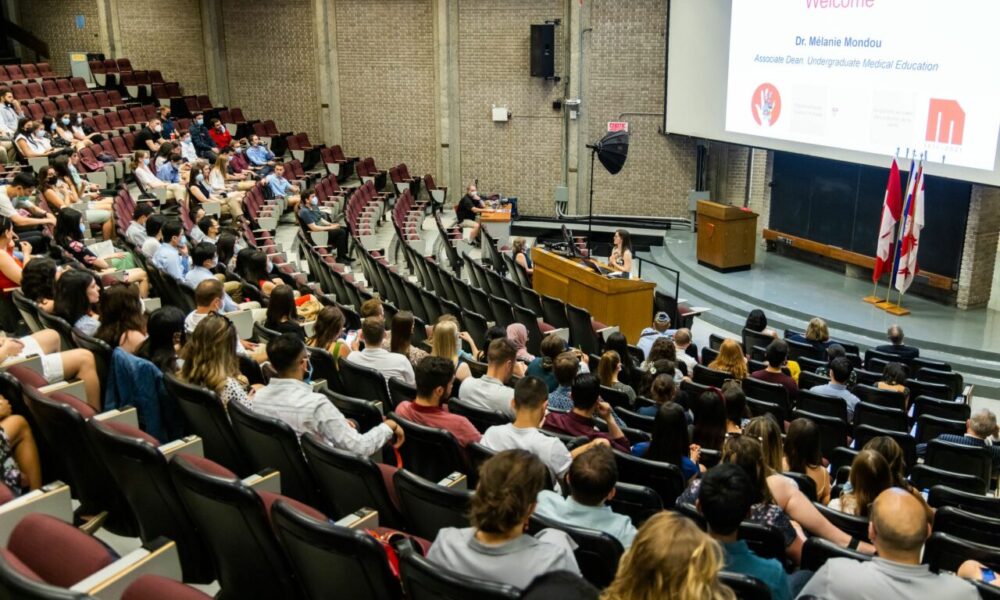Leacock 132
Any analysis of McGill’s intro-level science lecture halls has to start with Leacock 132, by far the most infamous room in a U0 Science student’s life. The largest lecture hall at McGill, Leacock 132 seats 650 people. While the space has an impressive resume, having hosted speakers such as Jane Goodall, Susan Sontag, and Ralph Nader, most students know it simply as one of the dreariest places to spend 50 minutes on campus.
“I’ve had six classes there and nothing of note has happened,” Ella Klein, U2 Arts, said, referencing their extensive experience with the lecture hall as a psychology major, in an interview with The Tribune. “Leacock 132 is a staple for psychology classes. I think all of the intro psychology classes are in it.”
One tip from an upper-year physics student: Keep a close eye on your pencils in this lecture hall, as the tightly-packed chairs make it almost impossible to find a missing item.
“I dropped my Apple Pencil one time in Leacock 132,” Mikey Baker, U2 Science, said in an interview with The Tribune. “It was the most stressful five minutes of my life.”
Stewart Biology S ¼
New students encounter a variety of problems with Stewart Bio S ¼ before taking their seat: How do you make it up the hill without working up a sweat? What’s the difference between the South and North buildings? How are you supposed to say ‘¼’, anyway? After trudging up the punishing slopes of Mount Royal, navigating Stewart Bio’s bizarre numbering system is sure to throw even the most dedicated engineering students off their game. And that’s in good weather— as Cypress Zufferli, U1 Arts & Sciences, explained, bad conditions can make it downright dangerous to make the trek up.
“When it’s raining or snowing, Docteur-Penfield turns into a slip ‘n slide,” Zufferli told The Tribune.
However, once you get inside, S ¼ is one of the better lecture halls of the bunch.
“The chairs are good,” said Zufferli. “I mean, they’re plastic, but they’re good. The annoying thing about it is the desks don’t move. So when you are trying to leave, you’re hitting your knees on the desks. And it makes for an awkward situation, if you’re late to class trying to get in.”
McIntyre Medical Building 522
McMed, one of the other major McGill buildings that require a trip up Mount Royal, received similar reviews from the science students I spoke to.
“I don’t have problems with the actual classroom,” Klein said. “But the way there is absolutely awful.”
In the case of McMed, which is even farther up the hill than Stewart Bio, the journey can be impossible for some students, although new students should note that there is a tunnel and elevator connecting Stewart Bio to McMed for ease of access.
“My biggest problem with McMed 522 is that I had a friend who, because of their disability, found it really difficult to get up the hill, especially in winter,” Baker explained, who took COMP 206 in McMed 522. “And, like, they just couldn’t attend class. We were lucky that that class was recorded, but I feel like some of this stuff goes beyond the level of inconvenience.”
Adams Auditorium
Adams Auditorium is certainly in a more convenient location than Stewart Bio or McMed, but the room makes up for that with its overall dreary atmosphere. The drooping ceiling tiles and flickering lights add to the ambiance created by the complete lack of windows and the indecipherable derivatives on the blackboard.
“There’s times where I’ve been in calc and I’m like ‘am I going crazy because I’ve been here for an hour and a half or is it because the lights do that?’” Zufferli said.
After your hour and a half in Adams Auditorium is over, make sure to budget a good five to ten minutes for exiting the lecture hall, winding out through the single stairwell and returning to the fresh air of Lower Field.









